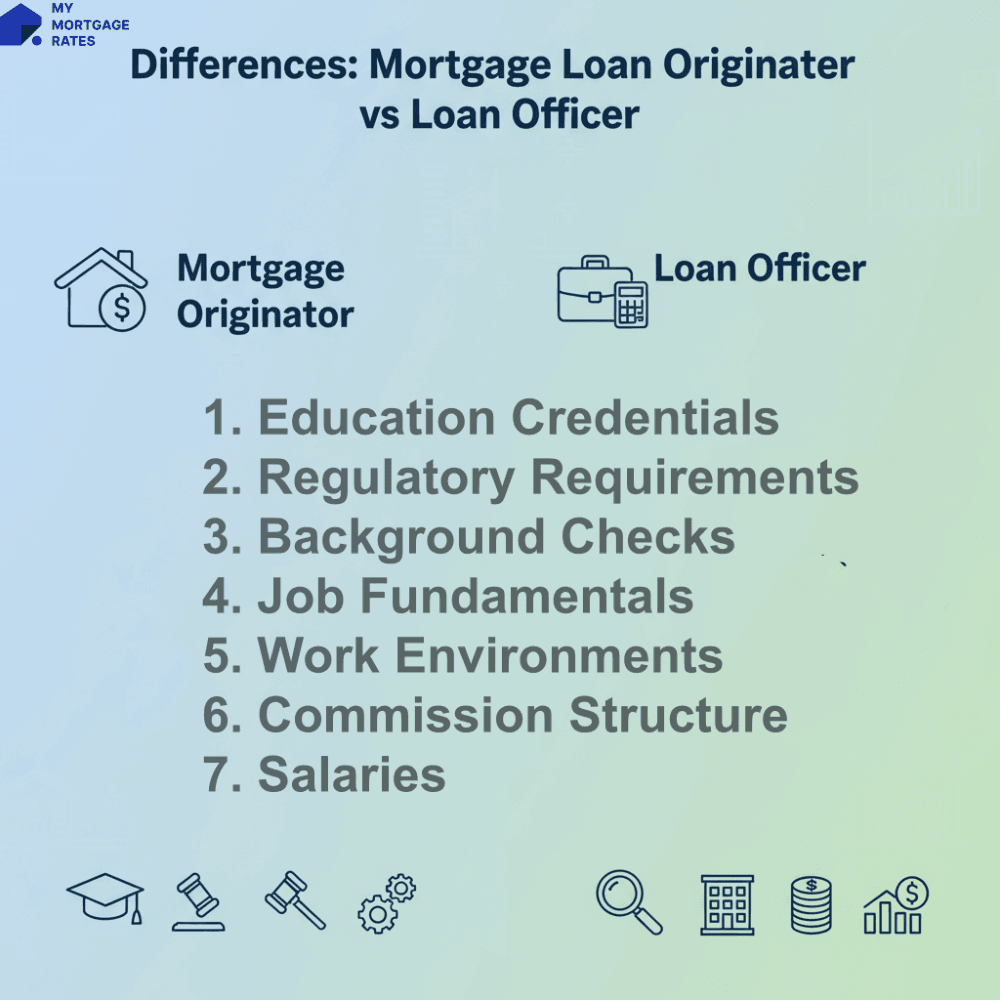
Mortgage Loan Originator vs Loan Officer: Differences and Similarities
Many borrowers may mix up with these terms: Mortgage Loan Originator and Loan Officer. While sharing the common places, they also have differences in terms of responsibilities, education credentials, regulatory requirements, background checks, salaries, etc. To learn more about a loan officer vs a loan originator. Let's dive in.
People Also Read:
- [Detailed Guide] What is a HELOC? All You Should Know Here
- How Much Mortgage Can I Afford? Know Your Affordability
- 6 Top Loan Origination Systems to Streamline Workflow in 2025
- How to Pay off Mortgage Faster? Pros, Cons, and 7 Ways for You
- How to Calculate Early Payoff of Mortgage? Formula and Penalty
What is a Mortgage Loan Originator (MLO)?
A Mortgage Loan Originator (MLO) is a licensed or federally-registered professional who works directly with borrowers to facilitate residential mortgage transactions. Their primary duties include taking loan applications, collecting and verifying financial documentation, explaining loan options, and submitting complete application packages to lenders for underwriting.
Under the SAFE Act, individuals who engage in residential mortgage origination must be either state-licensed or federally registered through the Nationwide Multistate Licensing System (NMLS). The federal registration path is available to employees of depository institutions (for example, banks, savings associations, and credit unions).
These professionals typically complete NMLS-approved 20 hours of pre-licensure education, pass the SAFE MLO test where required, and maintain continuing education as required by federal and state rules. MLOs most often focus on residential mortgage products like conventional, FHA, VA, USDA, ARMs, etc., and must follow applicable federal and state lending laws and disclosures.
Responsibilities of a Loan Originator
- Collect and verify financial documentation, including income statements, tax returns, credit reports, and employment verification, to assess borrower eligibility.
- Evaluate borrower creditworthiness by analyzing credit scores, debt-to-income ratios, and other financial metrics to determine appropriate loan programs.
- Explain available mortgage products and the tradeoffs of each program.
- Prepare and submit loan packages to underwriting with documentation that meets lender and regulatory requirements.
- Advocate for borrowers with underwriters and lenders within the guidelines and authorities of their employer. Please note that many MLOs do not have unilateral credit-approval authority.
- Maintain compliance with federal disclosure laws and state rules such as TILA, RESPA, ECOA, etc.
- Coordinate with real estate agents, appraisers, title companies, and other third parties to keep transactions moving toward closing.
- Build referral networks through partnerships with real estate professionals and past clients to generate business.
What is a Loan Officer (LO)?
A Loan Officer (LO) is a broader category of lending professional who may work across consumer, commercial, and mortgage lending. Loan officers evaluate, structure, and—in some cases—recommend or authorize loans across product lines such as mortgages, personal loans, auto loans, business lines of credit, and commercial real estate financing. Loan officers usually work for banks, credit unions, mortgage companies, and other lending institutions.
The title "loan officer" can cover a range of roles: some are focused exclusively on residential mortgage origination and therefore also meet MLO licensing/registration requirements, while others focus on commercial lending or consumer credit and follow different credentialing or internal training paths. Their scope is typically broader than an MLO, who is limited to residential mortgage origination under the SAFE Act.
Responsibilities of a Loan Officer
- Review and analyze loan applications across product lines to determine eligibility and risk.
- Interview applicants to gather income, asset, and liability information.
- Assess credit and collateral risk using institutional underwriting guidelines.
- Recommend approval or denial, or make credit decisions within delegated authority limits.
- Structure loan terms—interest rate, amortization, collateral, covenants—consistent with policy and risk limits.
- Monitor loan portfolios for performance, delinquencies, and refinancing opportunities.
- Comply with applicable regulations and institutional policies.
- Develop business through networking and customer relationships.

Differences: Mortgage Loan Originator vs Loan Officer
So, what is the difference between a Mortgage Loan Originator and a Loan Officer? In order to make it more clear, here's a breakdown in 7 aspects and you might as well walk through one by one.

Education Credentials
Mortgage Loan Originators must complete NMLS-approved pre-licensure education, which is commonly a 20-hour course requirement where applicable, and pass the SAFE MLO exam where state components apply. Many MLOs also hold bachelor's degrees, but the licensing prerequisites are the regulatory training and exam rather than a specific college degree.
Loan officers in banks or commercial lending often have bachelor's degrees in finance, business, or related fields because those positions require broader credit and financial analysis skills. However, exact education requirements vary by employer and role.
In short, MLOs' defining credential is their SAFE/NMLS licensing or registration. loan officers' educational expectations depend on the employer and loan type.
Regulatory Requirements
Under the SAFE Act, residential mortgage originators must be either state-licensed or federally registered via NMLS. State-licensed MLOs follow both federal baseline requirements and any state-specific rules. Federally registered MLOs, employees of depository institutions, are registered through NMLS rather than being state-licensed. Annual renewal windows and continuing education obligations are part of maintaining active status.
For state-licensed MLOs, the SAFE Act establishes a minimum continuing education standard of 8 hours per year, typically 3 hours Federal law, 2 hours ethics, 2 hours on nontraditional mortgage lending, and 1 hour of elective mortgage origination content. States may add additional CE requirements.
Background Checks
NMLS and SAFE Act processes include criminal background checks and credit authorization as part of the licensing/registration process. Fingerprinting is required at the application. Agencies and NMLS also validate credit reports. States or employers may require re-fingerprinting or updated background checks under certain circumstances, for example, if fingerprints on file are older than a state-specified period. Renewal and reactivation rules vary by state and institution.
Job Fundamentals
MLOs are typically origination-focused and often spend significant time on client acquisition like real estate agent relationships, marketing, referrals, and borrower education. Then hand the completed file to underwriting for approval. Many MLOs do not have final credit-approval authority.
Loan officers, depending on seniority and institution, may have credit decision authority and spend more time on underwriting, portfolio management, and structuring complex credit facilities in addition to origination.
Work Environments
MLOs work for mortgage lenders, brokerages, credit unions, and retail bank mortgage divisions. Many work remotely or with flexible client-facing hours to accommodate borrowers.
Loan officers, especially commercial lenders, may be more office-based or travel to meet business clients. Consumer-loan officers often work in branch or headquarters settings. Institutional culture and the loan specialty determine the day-to-day environment.
Commission Structure
MLOs commonly earn compensation through commission-based models, typically receiving 1% to 2% of the total loan amount, which they often split with their employing broker or lending institution. Some MLOs work on pure commission without base salaries, creating significant income variability based on production volume. Others receive modest base pay supplemented by performance bonuses tied to monthly loan closings. Federal regulations restrict certain compensation practices, prohibiting commission variations based on loan terms to prevent steering borrowers toward less favorable products for higher pay.
Loan Officers employed by banks and credit unions frequently receive salary-based compensation with performance bonuses rather than pure commission structures. Their earnings may include incentives for meeting quarterly targets, maintaining loan quality standards, or cross-selling banking products. Commercial loan officers typically earn higher base salaries with smaller variable components compared to mortgage-focused colleagues. The compensation philosophy reflects the different business models, with banks emphasizing stable employment relationships while mortgage brokerages embrace entrepreneurial commission structures that reward top producers substantially.
Salaries
According to the U.S. Bureau of Labor Statistics, loan officers earned a median annual wage of $74,180 in May 2024, translating to approximately $35.66 per hour. However, MLO incomes vary dramatically based on production levels, market conditions, and commission structures. Top-performing MLOs in competitive markets can exceed $150,000 annually, while those building their business or working in slower markets may earn considerably less. Geographic location significantly impacts earnings, with coastal metropolitan areas typically offering higher income potential than rural regions.
Loan Officers specializing in commercial lending often command higher salaries than residential mortgage professionals due to the complexity and size of transactions they handle. Entry-level loan officers typically start between $40,000 and $50,000 annually, while experienced commercial loan officers at major banks can earn $100,000 to $200,000 with bonuses. The salary differential reflects the educational requirements, lending authority, and revenue generation potential of different loan officer specializations. Career advancement into management roles such as Vice President of Lending, brings substantially higher compensation packages.
Similarities: Mortgage Loan Originator vs Loan Officer
Besides the differences, MLOs and LOs also have something in common. Let's take a look.
Clients
Both roles serve borrowers like individuals, families, and businesses, helping them secure financing. Both must understand borrower goals and constraints, recommend appropriate loan options, and help clients navigate documentation and closing processes. Strong customer service and clear communication are essential in both roles.
Skills
Both positions require strong analytical ability, familiarity with lending rules and underwriting, attention to detail, and good communication. Modern lending also demands proficiency with top loan origination systems, e-documentation workflows, and digital customer communication tools.
FAQs About Loan Originator vs Loan Officer
Q1. Is a loan officer the same as a loan originator?
Practically the terms are often used interchangeably in mortgage contexts, but technically a Mortgage Loan Originator (MLO) is a regulatory designation for those who originate residential mortgage loans and therefore must be licensed or federally registered through NMLS. A loan officer is a broader, title category that can include mortgage originators as well as commercial and consumer lending specialists.
Q2. Is a loan officer a high-stress job?
Loan officer work can be stressful: volume and income volatility for commission-driven roles, tight transaction timelines, and high client expectations contribute. Many lenders provide base salary and benefits, which reduce volatility. Many MLOs mitigate stress through systems, partnerships, and strong referral pipelines.
Q3. What are the disadvantages of being an MLO?
Common downsides include income variability, especially for commission-heavy roles, significant time spent on business development, and ongoing licensing/CE costs and compliance responsibilities. Market cycles and interest-rate volatility can strongly affect originations and income.
Q4. How to stand out as a loan officer?
Stand out by delivering excellent communication, building reliable referral networks, specializing (first-time buyers, self-employed borrowers, VA loans, etc.), leveraging technology for fast loan origination processing, and consistently delivering clean, underwriter-friendly files.
Conclusion
MLOs and loan officers share core lending skills and borrower-facing duties but differ in regulatory definition, scope of lending authority, and typical compensation models.
- For borrowers, the professional's competence and transparency matter more than the title. MyMortgageRates offers an excellent platform for you to meet loan officers nearby and get a direct contact.
- For professionals, the right path depends on whether you prefer a sales-and-origination focus, common for many MLO roles, or a broader lending/credit role, common for many bank loan officers. To improve efficiency and close more loans, Zeitro is a wonderful LOS with AI enhancements.